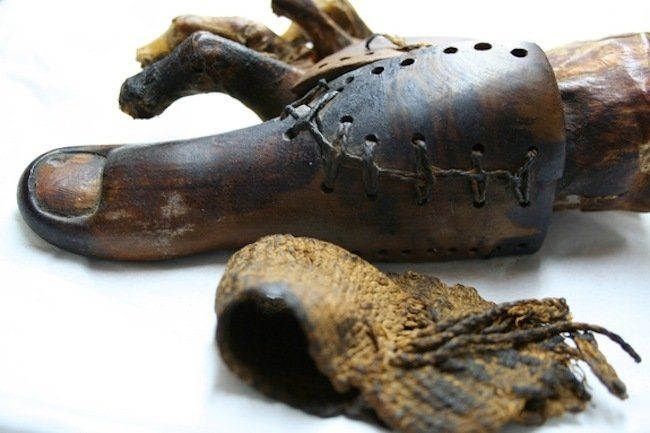A History of Prostheses: From Pirate Peglegs to Robotic Arms
By William Huang
It is 950 B.C. You are a noble Egyptian woman living in the city of Thebes, the capital of Egypt during the period of the New Kingdom. Sadly, due to diabetes, you must lose your toe due to higher blood levels. Doctors around you suggest a replacement by building a wooden version. Congratulations! This small digit makes you the first known human to have a prosthetic limb!
This woman's toe, later dubbed the “Cairo Toe”, was the first real prosthetic with a functional purpose. The big toe is responsible for carrying 40 percent of a person’s body weight and allows for forward propulsion. Even more impressive is the fact that modern prosthetic toes are produced only after an intensive study of the person’s gait using equipment.

Image credit: The University of Manchester
However, prostheses did not advance quickly after this initial discovery. Consider the Dark Ages. During this period, knights wore iron prosthetic limbs built by the armorer. However, these limbs were not practical in battle. Instead, they were used to hide the missing body part as it was considered a deformity.
A more famous example is seen with pirates. Peglegs with wooden cores and metal hands shaped into hooks have actually been the prosthetic standard throughout much of history. Although exaggerated by Hollywood, some pirates did rely on these prostheses. The ship’s cook was the one who often performed the surgery.
Fast forward to the late 16th century. As a doctor, Ambroise Paré was disturbed by the reaction of some of the people whom he had saved. He found that some soldiers took their own lives rather than live without limbs, or with terrible wounds. Amputation was often feared more than death in some cultures. It was believed that it not only affected the amputee on earth, but also in the afterlife. To try to combat this problem, Paré began crafting artificial limbs. Along with improving amputation techniques and survival rates during his time, he developed prosthetic limbs for all parts of the body. He used his understanding of anatomy to design prosthetics that mimic the function of biological limbs. He was the first to develop an above-knee prosthetic with an adjustable harness and a hinge-knee with lock control – both of which are still used today. He also transitioned away from wood in favor of much lighter prosthetics made of leather, paper, and glue. Today he is considered the father of the modern prosthetic limb.

Image credit: Britannica
In 1690, Dutch surgeon Pieter Verduyn developed a lower leg prosthesis with hinged and a leather cuff for better attachment. In 1800, James Potts invented a knee calf and thigh socket made of wood, and a flexible foot attached with catgut tendons to a steel knee joint. Slowly, prosthesis were not only improving in functionality, but also become aesthetically pleasing.
In 1945, the National Academy of Sciences established the Artificial Limb Program in response to the influx of World War II amputees. Since this, advances in computer design methods, materials, and surgical techniques have brought prosthetics to life.
Today, we are edging closer to creating prostheses capable of mirroring a biological limb. Blade prosthesis have given running capabilities, microprocessors increase flexibility in different environments, and neuroprosthetics bring in the possibility of mind-controlled robotic arms. As these technologies continue to advance, I’m excited to see what the future holds for amputees.
Citations
https://www.ncbi.nlm.nih.gov/pmc/articles/PMC3664166/
https://www.bbc.com/future/article/20151030-the-geniuses-who-invented-prosthetic-limbs
https://synergypo.com/blog/a-short-history-of-prosthetics/
https://www.livescience.com/4555-world-prosthetic-egyptian-mummy-fake-toe.html
Image credit: Science Museum Group
All Rights Reserved | Safe Covid-19 Relief Engineerning



